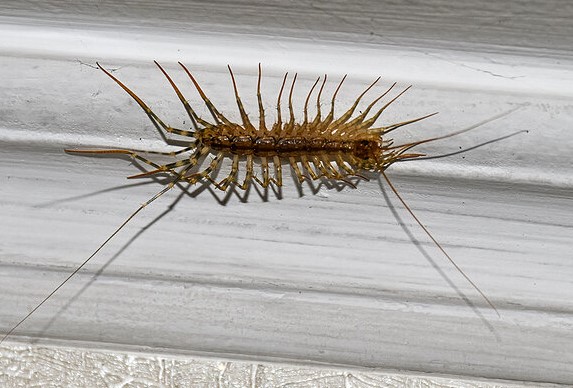If you don’t like insects, you probably won’t like house centipedes either. House centipedes are common household insects known for their many legs that help them scurry by in the blink of an eye. Although house centipedes don’t pose a threat to humans or harm the infrastructure of your home, they can be alarming to see.
The house centipede (Scutigera coleoptrata) is the most common centipede found in the U.S. These centipedes are sometimes referred to as “hundred-leggers,” due to their many pairs of legs. House centipedes are usually about an inch or two long with bodies that are divided into 15 segments, each with a pair of long legs. Some species of centipedes have more legs, but always in an odd numbered pair of legs.
Centipedes are generally dark brown or yellow and sometimes have darker colors and markings. Adult centipedes have three dark parallel lines running from their head to the rear end of their bodies and a hair-covered pair of antennae on their heads. While some centipede species have compound eyes containing up to 200 optical units, others have a few simple eyes on each side of the head. Some centipedes don’t even have any eyes.
House centipedes have a pair of legs called forcipules right below their mouths, converted to carry out pincer-like actions. They use these pincer-like legs to discharge a venomous sting at their prey or use it for self-defense. The pair of legs at the end of centipedes’ bodies is very long and resembles the antennae in front. This makes it tough for the centipede’s prey to differentiate the front end from the rear.
Centipedes help by preying on other common household pests such as cockroaches, silverfish, firebrats, carpet beetle larvae, spiders, termites, bed bugs, and other small arthropods. Their long legs allow them to run fast as they chase their prey, pounce on them, and wrap their long spindly legs around them, preventing them from escaping.
The most common hideouts of house centipedes are damp and cool spots
Centipedes are nocturnal creatures that venture out in the dark to hunt. They hide during the daytime in dark, damp, and cool places such as those in basements, closets, bathrooms, potted plants, unexcavated areas under the house, and under the bark of firewood stored indoors. House centipedes also thrive outdoors and live under logs, rocks, and fallen tree bark.
Since centipedes are nocturnal, it can be tough to determine whether you have them in your house. One of the first signs of a centipede infestation is seeing them regularly in your home. But this could signify the presence of other arthropods or pests that are prey for the house centipede–a sign of a problem with other pests.
House centipedes are generally only considered a nuisance, they don’t harm or destroy stored products, fabrics, pets, humans, or the structural integrity of your building. All house centipedes are venomous, but they typically run away from humans, and they very rarely bite. Even if house centipedes bite you, it’s considered harmless.

